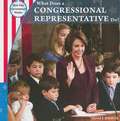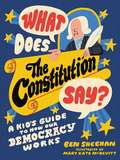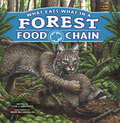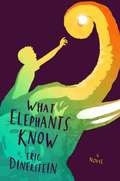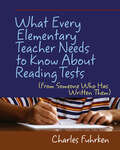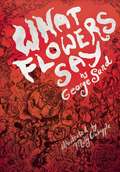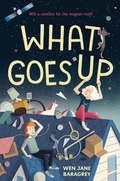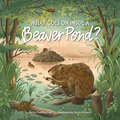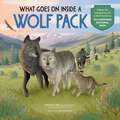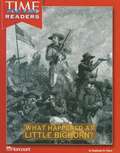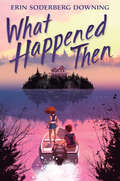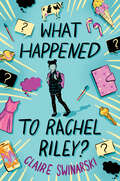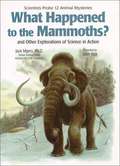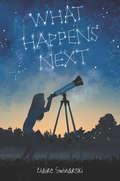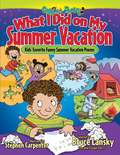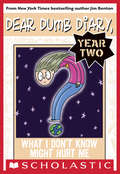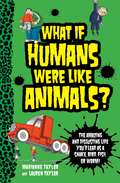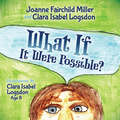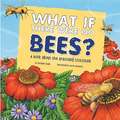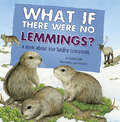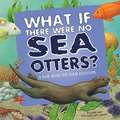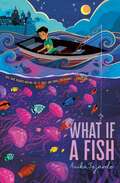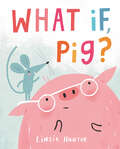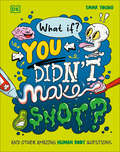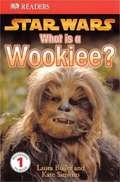- Table View
- List View
What Does a Congressional Representative Do?, First Edition (How Our Government Works)
by David J. JakubiakDiscusses the duties of congressional representatives, how they get into office, how states are represented, the leadership of the House of Representatives, working with the Senate, committees, and where the House meets.
What Does the Constitution Say?: A Kid's Guide to How Our Democracy Works
by Ben SheehanIf you've never read the Constitution, let this guidebook help you! Featuring fun facts, cool illustrations, and even hilarious jokes, What Does the Constitution Say? will help you understand how our American government really works. Written more than 230 years ago, the Constitution can be hard to understand (even for adults). But it also gives you what you need to make our country the best it can be for everyone. What Does the Constitution Say? takes you on a tour of the whole Constitution while explaining what its fancy words really mean. From the Preamble to the 7 Articles to the 27 Amendments (so far), this fun-to-read guide is packed with bite-sized info, historic quotes, and graphics on important topics such as:Why the Constitution is a "living document"How the first attempt at a constitution (the Articles of Confederation) failedWhat powers the president does (and doesn't) haveKey figures like James Madison, Alexander Hamilton, and George WashingtonA bonus section on the Declaration of IndependenceAnd much more!
What Eats What in a Forest Food Chain (Food Chains Ser.)
by Lisa J. AmstutzA temperate deciduous forest teems with life. From a tall oak tree to a turkey vulture, the living things in this books are linked together in a food chain. Each one of them needs the others in order to live. Find out what eats what in a forest!
What Elephants Know (What Elephants Know Ser.)
by Eric DinersteinAbandoned in the jungle of the Nepalese Borderlands, two-year-old Nandu is found living under the protective watch of a pack of wild dogs. From his mysterious beginnings, fate delivers him to the King's elephant stable, where he is raised by unlikely parents-the wise head of the stable, Subba-sahib, and Devi Kali, a fierce and affectionate female elephant. When the king's government threatens to close the stable, Nandu, now twelve, searches for a way to save his family and community. A risky plan could be the answer. But to succeed, they'll need a great tusker. The future is in Nandu's hands as he sets out to find a bull elephant and bring him back to the Borderlands. In simple poetic prose, author Eric Dinerstein brings to life Nepal's breathtaking jungle wildlife and rural culture, as seen through the eyes of a young outcast, struggling to find his place in the world.
What Every Elementary Teacher Needs to Know About Reading Tests: (From Someone Who Has Written Them)
by Charles FuhrkenWhen he was a student struggling to concentrate on dreadfully boring passages of standardized reading tests, Charles Fuhrken remembers thinking to himself, 'Who writes this stuff?' He had no idea that one day it would be him. ' Fuhrken has spent years working as a writer for several major testing companies, and he believes that what he's learned about testing could be very usefuleven liberatingfor teachers interested in teaching effective reading strategies as well as preparing students for reading tests. In What Every Elementary Teacher Needs to Know About Reading Tests (From Someone Who Has Written Them), Fuhrken' takes the mystery out of reading tests. He explains how reading tests are created, how standards are interpreted and assessed, and how students can apply their knowledge of reading to standardized tests.' ' What Every Elementary Teacher Needs to Know About Reading Tests sets the record straight about the myths and realities of tests and offers extensive, practical strategies that help students perform well on test day. This ready to use, easy to understand resource provides a wealth of information about reading tests, including high-quality preparation materials; samples of the most frequently assessed reading standards; and more than thirty engaging, core-reading activities. ' Tests require a special kind of savvy, a kind of critical thinking and knowledge-application that is not always a part of classroom reading experiences. That's why teachers need to provide students with sound, specific information about reading tests. Only then can students feel prepared and confident on test day. '
What Flowers Say
by George Sand Molly Crabapple Holly Erskine HirkoRoses plead to go out to dance; an old oak tree offers advice; paintings of gods and goddesses come alive. In What Flowers Say, renowned writer George Sand dares children to fantasize, to believe in an alternate world. This magical collection, originally penned for her grandchildren, calls into question what is real, a life lesson from someone who refused to accept the gender roles available to women in the nineteenth century. Sand shares her love and immense knowledge of science and mythology, engages issues of class and character, and captures the wonder and determination of a curious child, offering all of us a true sense of infinite possibilities--well beyond the world we live in.George Sand (1804-76) is considered the first professional woman writer of fiction. She wrote many novels, including Indiana and Léila, plays, newspaper articles, and a memoir, Story of My Life. The movie Impromptu is based on her life.Molly Crabapple is a painter, illustrator, and writer based in New York. She has written many books, including Discordia and Week in Hell, and produced work on subjects including the Spanish general strike, her former career as a pinup model, her arrest during Occupy Wall Street, and her visit to Guantanamo Bay. Her illustrated memoir, Drawing Blood, is forthcoming in 2015.
What Goes Up
by Wen Jane BaragreyWhat goes up . . . comes down on Robyn Tinkerbell Goodfellow's roof! Will a rogue NASA satellite crush her house before Robyn can set things right?Robyn Tinkerbell Goodfellow (yes, that's actually her name) has a target on her roof. Well, not a real one, but everything seems to land there: paper airplanes, lost kites, socks, cats, and once even a skydiver! In the town of Calliope, Robyn and her magnet roof are famous--for being weird. That wasn't such a big deal . . . until now! A rogue NASA satellite is falling out of orbit and is going to hit Earth. NASA says it will probably land in the ocean, but Robyn knows better--that satellite is headed for her roof. To make matters worse, Robyn discovers that she doesn't just have a fairy middle name. When her class reads A Midsummer Night's Dream, she learns that Robin Goodfellow is a fairy! Which means if the satellite flattens her, everyone will laugh at her name in the news stories. Robyn realizes what she needs to do: find her long-lost dad so he can help her change her name and protect her from the satellite! Both surprising and relatable, this middle-grade novel will have readers wishing they could move to the small town of Calliope, laugh with the larger-than-life characters, and race against the clock to save Robyn from NASA's mistake.
What Goes on inside a Beaver Pond?
by Becky Cushing GopDive into the fascinating world of beavers—the swimmers, builders, and engineers of the animal kingdom! What Goes on inside a Beaver Pond? takes kids ages 8 to 10 on a journey through a year in the life of a young beaver (called a "kit"). This is an exciting year as the young beaver leaves her family lodge and moves throughout the Yokun Brook waterways, seeking a new home for herself. Throughout the seasons, vibrant illustrations and descriptions reveal the hidden inner-workings of a beaver lodge, how beavers fell trees with their teeth and create a wetland habitat, how they collect food and ward off predators, and what daily life is like within a beaver colony. Educational side panels enhance the story with details about beaver behavior and anatomy, as well as information about what other animal inhabitants of the pond are up to throughout the year. Author Becky Cushing Gop is an environmental educator and director of Mass Audubon&’s Pleasant Valley Wildlife Sanctuary where the story takes place. Nature illustrator Carrie Shryock&’s lively and charming graphics bring the young beaver&’s story to life for nature-curious kids.
What Goes on inside a Wolf Pack: Follow the Adventures of a Wolf Family in Yellowstone National Park
by Kathleen YaleJoin a pack of wolves during a year in Yellowstone National Park as they rear new pups, traverse their territory, cross rivers, chase ravens, bump into bears and meet a host of other diverse animals. With vibrant illustrations and engaging storytelling, a family of wolves comes to life. Through the seasons, readers will learn about all aspects of wolf life, including: ·Spring denning and the first months of life with a new litter of pups ·The excitement and danger of the hunt ·Defending the territory from other wolf packs ·Interactions with bears, coyotes, ravens, elk, bison, and a host of other animals Informative side panels enhance the story with details about wolf behavior and anatomy, as well as facts about other animals and plants that inhabit the ecosystem. Author Kathleen Yale has worked as a wildlife field biologist and has teamed up with the International Wolf Center, one of the world's most respected nonprofits for education and research about wolves. Nature illustrator Carrie Shryock&’s lively and charming graphics make the wolf pack's story come alive. This publication conforms to the EPUB Accessibility specification at WCAG 2.0 Level AA.
What Happened At Little Bighorn?
by Stephanie St. PierreThere were many more battles between the Army and the Native Americans, especially the Lakota. The last battle of the Indian wars took place at Wounded Knee on December 29, 1890. By 1900 the life on the open plains that the Lakota, Cheyenne, and other Indians had known and loved was over.
What Happened Then
by Erin Soderberg DowningIn this alternating narrative by bestselling author Erin Soderberg Downing, a decades-old family secret is buried within the sand, water, and woods… waiting for cousins Avery and Jax to find it and uncover the truth.Avery is a firecracker. In a crayon box of colors, she’s the shocking pink and laser lemon, when all she wants is to be a quiet tan or soft cornflower blue. Her cousin, Jax, is a wall flower, because sometimes it’s better to stay quiet when the alternative is to be told that you’re doing or saying everything wrong. They seem to be the only ones who don’t know what happened years ago when their family shattered and went off in different directions.When their beloved Aunt Robbie summons the large, estranged family together for a gathering at their broken-down family cabin on Crooked Lake, instead of getting the answer, Aunt Robbie delivers some devastating news. And by the end of the summer, Avery and Jax learn that the island that’s been a part of their family for generations is going up for sale.Forced to stay in this string of cabins with their estranged family to get it into shape to sell, Avery and Jax begin to dig through the history of the long-abandoned house and its contents… including a sprinkling of diary pages that were hidden around the island decades ago, the summer their family was torn apart.In this alternating narrative by bestselling author Erin Soderberg Downing, two cousins are finally beginning to understand the joy of family--however cracked and imperfect theirs might be. But if they have any chance of gluing their broken family back together, they’ll have to first figure out what happened then.
What Happened to Rachel Riley?
by Claire SwinarskiIn this engrossing and inventive contemporary middle grade novel that's Where'd You Go Bernadette? with a #MeToo message, an eighth grader uses social media posts, passed notes, and other clues to find out why a formerly popular girl is now the pariah of her new school. <p><p>Anna Hunt may be the new girl at East Middle School, but she can already tell there’s something off about her eighth-grade class. Rachel Riley, who just last year was one of the most popular girls in school, has become a social outcast. But no one, including Rachel Riley herself, will tell Anna why. <p><p>As a die-hard podcast enthusiast, Anna knows there’s always more to a story than meets the eye. So she decides to put her fact-seeking skills to the test and create her own podcast around the question that won’t stop running through her head: What happened to Rachel Riley? <p><p>With the entire eighth grade working against her, Anna dives headfirst into the evidence. Clue after clue, the mystery widens, painting an even more complex story than Anna could have anticipated. But there’s one thing she’s certain of: If you’re going to ask a complicated question, you better be prepared for the fallout that may come with the answer.
What Happened to the Mammoths?: And Other Explorations of Science in Action
by Jack MyersIntriguing questions about animals are answered by scientists in these twelve explorations taken from the award-winning column in Highlights for Children magazine.
What Happens Next
by Claire SwinarskiIn this heartfelt and accessible middle grade novel perfect for fans of The Thing About Jellyfish, a young girl throws herself into solving a local mystery to keep from missing her older sister, who has been sent to an eating disorder treatment facility. <P><P>Astronomy-obsessed Abby McCourt should be thrilled about the solar eclipse her small town of Moose Junction is about to witness, but she’s not. After her older sister Blair was sent away for an eating disorder, Abby has been in a funk. <P><P>Desperate to dull the pain her sister’s absence has left, she teams up with a visiting astronomer to help track down his long-lost telescope. Though this is supposed to take Abby’s mind off the distance between her and Blair, what she finds may bring her closer to her sister than she ever thought possible.
What I Did on My Summer Vacation: Kids' Favorite Funny Summer Vacation Poems (Giggle Poetry)
by Bruce LanskySummer days are here again!Here are over forty sidesplitting poems about summer vacation, covering everything from the much-anticipated last day of school to family road trips, wacky days at summer camp, learning how to swim, dizzying roller coaster rides, fun-filled days at the beach, and finally, the dreaded first day of the new school year. These hilarious poems written by Bruce Lansky, Kenn Nesbitt, Robert Pottle, Eric Ode, and Neal Levin, and the rest of the all-star gang of Giggle Poets are sure to make you count the days until summer vacation begins!Beach Book Festival Award (Honorable Mention Finalist: Children's Books), USA Book News (Best Books Award Finalist), Moonbeam Children's Book Awards (Children's Poetry Gold Award).
What I Don't Know Might Hurt Me (Dear Dumb Diary Year Two #4)
by Jim BentonBestselling author Jim Benton is back, continuing a new spin on a favorite series!Dear Dumb Diary, Just when I was pretty sure we could let the Student Awareness Committee quietly die a dignified death like some majestic old elephant or the Square Dancing Club, Angeline has to be aware of something. Great.And, of course, it couldn't be something interesting like nail polish or why maybe there should be a special class in nail polish and how to get it out of your beagle's ear. (Mom, if you're reading this, I'm not admitting anything. Somebody else could have painted a heart in his ear.)Angeline just had to be aware of one of those THINGS THAT ADULTS LIKE.
What If Humans Were Like Animals?
by Marianne TaylorEveryone has wondered what it would be like to be their pet dog or cat--covered in fur, walking on all fours. But have you ever wondered what it would be like to have eight eyes and legs like a spider? What if you drank through a straw that was part of your mouth like a butterfly? The imagination runs wild in this book that explores the hilarious possibilities of what it would be like if people had the traits of animals all while learning distinct and disgusting facts about these animals. For instance, picture what it would be like if people . . . . . . carried their young in their mouths like jawfish do. . . . were as strong as carpenter ants, which can lift 850x their own weight. . . . could stretch over 10x their own length the way that ribbon worms can. . . . had eyes in their hands like starfish. . . . had skunk defenses and squirted some stink out of their rears when they're attacked.What If Humans Were Animals imagines all these possibilities and more in hilariously graphic picture and gag-provoking text that entertains as well as educates. Readers will never be able to forget all these animal facts when they picture them in this zany and outrageous context.
What If It Were Possible?
by Joanne Fairchild Miller Clara Isabel LogsdonThe author and her eight-year-old granddaughter, Clara, explore the world of their imaginations in this unique children&’s book illustrated by Clara. What if it were possible . . . for a dog to climb a tree? What if it were possible to climb like you and me? What if pretty butterflies could spread their wings and swim? And elephants could wear their trunks while working out at gyms? Anything can happen if you think it might. In your imagination, ANYTHING is RIGHT! Eight-year-old Clara has a vivid imagination. One day while visiting her Yia-Yia, author Joanne Miller, they watched Clara&’s dog, Harley, desperately try to climb a tree to get a squirrel. Then Joanne asked Clara a provocative question: &“What if it were possible for a dog to climb a tree?&” And the rest is history. Joanne and Clara had lots of giggles coming up with crazy lines for this book, and Clara drew each illustration with water color pencils. Clara and her Yia Yia don&’t believe play and imagination are only for children. In What If It Were Possible? they demonstrate the limitless wonders we can discover in our minds.
What If There Were No Bees?: A Book About The Grassland Ecosystem
by Carol Schwartz Suzanne SladeGrassland ecosystems can be found on nearly every continent. Countless animals and plants live in them. So what difference could the loss of one animal species make? Follow the chain reaction, and discover how important honey bees are.
What If There Were No Lemmings?: A Book About The Tundra Ecosystem (Food Chain Reactions Ser.)
by Suzanne SladeThe tundra ecosystem is vast, covering a large part of the far north. Countless animals and plants live there. So what difference could the loss of one animal species make? Follow the chain reaction, and discover how important lemmings are.
What If There Were No Sea Otters?: A Book About The Ocean Ecosystem
by Carol Schwartz Suzanne SladeThe ocean ecosystem is huge, covering most of our planet. Countless animals and plants live there. So what difference could the loss of one animal species make? Follow the chain reaction, and discover how important sea otters are.
What If a Fish
by Anika FajardoA whimsical and unflinchingly honest generational story of family and identity where hats turn into leeches, ghosts blow kisses from lemon trees, and the things you find at the end of your fishing line might not be a fish at all. <P><P>Half-Colombian Eddie Aguado has never really felt Colombian. Especially after Papa died. And since Mama keeps her memories of Papa locked up where Eddie can&’t get to them, he only has Papa’s third-place fishing tournament medal to remember him by. He’ll have to figure out how to be more Colombian on his own. <P><P>As if by magic, the perfect opportunity arises. Eddie—who’s never left Minnesota—is invited to spend the summer in Colombia with his older half-brother. But as his adventure unfolds, he feels more and more like a fish out of water. Figuring out how to be a true colombiano might be more difficult than he thought.
What If, Pig?
by Linzie HunterYou’re not going to find a more heartwarming dynamic duo than Pig and Mouse! Join Pig as he learns how to turn his “what if" worries from anxiety to optimism, all with the help of his loving friend Mouse."Readers will certainly empathize with Pig and his emotions." —Kirkus “Hunter’s picture book will draw its audience with vibrant colors, oh-so-adorable characters, and plenty of silliness” –Bulletin of the Center for Children’s Books"Young readers will learn that being afraid is a common, temporary feeling, and that they can talk to others about it." —School Library Journal Mouse has never had a friend quite like Pig. Pig is so incredibly kind, fabulously fun, but he also has a big secret—he’s a tremendous worrier!When Pig gets the brilliant idea to throw a party for Mouse and their friends, he can’t help but think of everything that could possibly go wrong. After all, what if a lion eats all the invitations? What if nobody comes? Or worse, what if everyone comes and has an awful time?In this adorable story, Linzie Hunter’s charming, bright illustrations pair perfectly with her sweet and funny story about friendship and the endless wonder of "what if" that readers of all ages can relate to. This picture book is a great conversation starter in the home or classroom.
What If... You Didn't Make Snot?: And Other Amazing Human Body Questions (What If?)
by Emma YoungFind out the answers to 33 crazy and laugh-out-loud questions with science author Emma Young.Prepare to learn all about the human body, from blood vessels to the brain and nerves to nutrients, in this engaging question-and-answer book. What If You Didn’t Make Snot? is not your usual science book. Children aged 7-9 will be drawn into each topic with one of 33 amusing questions that are guaranteed to make kids think about anatomy in a whole new way. Author Emma Young explains the answers with humor and plenty of science facts that kids will be racing to share with friends and family.This human body book for children offers:Fun and engaging content by science author Emma Young.33 laugh-out-loud questions with key science facts are woven into the answers.A mix of photography and cartoon-style illustrations that bring the questions to life.Curriculum-aligned and age-appropriate material about the human body for children.Children can dip in and out of bite-sized information on each page, filled with attention-grabbing photography and quirky illustrations. Even reluctant readers will find this human body book entertaining, as they find out the answers to the wacky, bizarre, and gross questions.
What Is A Wookiee?
by Laura Buller Kate SimkinsYoung fans can learn more about alien characters from the Star Wars universe--from Chewbacca, Han Solo's loyal Wookiee companion, to Jedi Master Yoda and the Gungun race.
